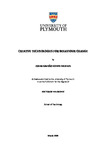Creative Technologies for Behaviour Change
| dc.contributor.supervisor | Andrade, Jackie | |
| dc.contributor.author | Galvao Gomes da Silva, Joana | |
| dc.contributor.other | Faculty of Health | en_US |
| dc.date.accessioned | 2020-07-08T14:37:26Z | |
| dc.date.issued | 2020 | |
| dc.identifier | 10491451 | en_US |
| dc.identifier.uri | http://hdl.handle.net/10026.1/15852 | |
| dc.description.abstract |
This thesis presents innovative uses of technology to support motivation, using motivational interviewing (MI) and functional imagery training (FIT) scripts developed specifically for remote delivery. MI scripts aimed to develop discrepancy, evoke solutions and promote self-efficacy. FIT scripts included multi-sensory mental imagery exercises at key points in the MI scripts. Four methods of delivery were developed: a human video-counsellor, a NAO robot programmed with Choregraphe software, a video robot counsellor for comparison with the human video-counsellor, and a life-sized two dimensional 'holographic' projection. Four empirical studies tested these developments in participants wanting to become more physically active. Study 1 (N=18) and Study 2 (N=20) used qualitative methods to explore the usability and acceptability of MI delivered by a pre-recorded human video counsellor and NAO robot respectively. Analysis of participants' verbal dialogue with the video counsellor in Study 1 showed high levels of change talk, an important ingredient of effective MI. In both studies, participants reported that voicing their goals aloud was helpful but they were somewhat frustrated by the lack of personalised response. Participants positively appraised the non-judgemental aspect of the interview with the robot. Study 3 tested if virtual FIT would be more acceptable and effective than virtual MI. Ninety-eight participants received FIT or MI delivered by a video robot, and compared to a wait-list control group. In Study 4, 104 participants were randomized to a monologue version of FIT delivered by a human counsellor projected as a two-dimensional life-size hologram, or on a computer screen, or a wait-list control condition. Neither Study 3 or 4 found any quantitative effect of virtual counselling on physical activity, self-efficacy, or motivation. As in studies 1 and 2, although participants found the technological interaction somewhat impersonal, qualitative responses were largely positive: participants liked the opportunity to voice their goals, reported a motivational boost, and perceived the virtual coaches as non-judgmental. This research has shown that people perceive benefits from speaking aloud about their goals and problems, and even engaging silently in imagery-based counselling. There is potential to deliver a brief motivational intervention that is fully-automated and acceptable to participants. | en_US |
| dc.language.iso | en | |
| dc.publisher | University of Plymouth | |
| dc.subject | Behaviour change | en_US |
| dc.subject | Motivational interviewing | en_US |
| dc.subject | Motivation | en_US |
| dc.subject | Physical activity | en_US |
| dc.subject | Exercise | en_US |
| dc.subject | Qualitative research | en_US |
| dc.subject | Computer-assisted therapy | en_US |
| dc.subject | Robotics | en_US |
| dc.subject | Social robotics | en_US |
| dc.subject | Virtual coaching | en_US |
| dc.subject | Video coaching | en_US |
| dc.subject | Functional imagery training | en_US |
| dc.subject.classification | PhD | en_US |
| dc.title | Creative Technologies for Behaviour Change | en_US |
| dc.type | Thesis | |
| plymouth.version | publishable | en_US |
| dc.identifier.doi | http://dx.doi.org/10.24382/825 | |
| dc.rights.embargodate | 2021-07-08T14:37:26Z | |
| dc.rights.embargoperiod | 12 months | en_US |
| dc.type.qualification | Doctorate | en_US |
| rioxxterms.funder | Seventh Framework Programme | en_US |
| rioxxterms.identifier.project | Marie Curie Initial Training Network FP7-PEOPLE-2013-ITN, CogNovo, grant number 604764 | en_US |
| rioxxterms.version | NA | |
| plymouth.orcid.id | https://orcid.org/0000-0002-3182-3179 | en_US |
Files in this item
This item appears in the following Collection(s)
-
01 Research Theses Main Collection
Research Theses Main


